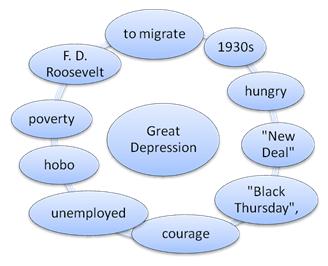|
AT A GLANCE
1. Look at the photograph of Migrant Mother. Use your imagination to answer the worm-up questions:
- What do you feel looking at this picture? What impression does it produce on you?
- What does the name of the photograph tell about the woman and her family?
- How old do you think the woman is?
- How many kids might she have?
- What sort of job might she do?
- What social layer might she belong to?
- Does she have a husband? What is he?
IHandy vocabulary
The words from the chart below can help you describe the atmosphere of the picture and your impressions of it.
I am
I feel |
depressed inspired tense sorry
shocked touched amazed sad |
The picture is
The woman is
The impression is
The atmosphere is |
gloomy inspiring hopeless
tough destructing forlorn
touching disturbing hopeful
depressing tough wistful |
* SIMPLE FACT
2. Read the story of Migrant Mother told by the photographer Dorothea Lange. Check if your first impression of the image was right. Say how this information contrasts to the impression you’ve just had?
The photo belongs to the series of pictures under the title “One third of a Nation”. It was made by Dorothea Lange during the period of American history called “the Great Depression” in 1930s. This portrait depicts pea pickers in California, centering on Florence Owens Thompson, age 32, a mother of seven children, in Nipomo, California, March 1936. Lange was concluding a month's trip photographing migratory farm labor around the state for what was then the Resettlement Administration. In 1960, Lange gave this account of the experience:
“I saw and approached the hungry and desperate mother, as if drawn by a magnet. I do not remember how I explained my presence or my camera to her, but I do remember she asked me no questions. I made five exposures, working closer and closer from the same direction. I did not ask her name or her history. She told me her age, that she was thirty-two. She said that they had been living on frozen vegetables from the surrounding fields, and birds that the children killed. She had just sold the tires from her car to buy food. There she sat in that lean- to tent with her children huddled around her, and seemed to know that my pictures might help her, and so she helped me. There was a sort of equality about it. “ (From: Popular Photography, Feb. 1960). (http://www.loc.gov/rr/print/list/128_migm.html)
BEHIND THE PICTURE
3. Look at the key words given below. All of them refer to the concept of the Great Depression. Do any of the key words look familiar? Share your knowledge of them with the group.

4. Work in pairs. Read the definitions of some key words given below and try to make a logical connection between all of them. Share your results with the group.
- to migrate – to move from one’s mother country to another country seeking better life conditions
- poverty – the condition of being extremely poor
- unemployed – not having a job that provides money
- courage – the ability to control your fear in a dangerous or difficult situation
- hungry – wanting or needing food
- hobo – someone who does not have a job or a house and who moves from one place to another
5. Read the text about the Great Depression. Fill in the gaps with any necessary key word from the scheme.
America's "Great Depression"
America's "Great Depression" began with the dramatic crash of the stock market on "____________", October 24, 1929 when 16 million shares of stock were quickly sold by panicking investors who had lost faith in the American economy. At the height of the Depression in 1933, nearly one third of the Nation's total work force, 12,830,000 people were _____________. It was the worst economic disaster in American history. Farm prices fell so drastically that many farmers lost their homes and land. Many went ______________.
Unable to help themselves the American public looked to the Federal Government. The people elected Franklin D. ______________ as their president in 1932. Roosevelt was a bold experimenter and a man of action. Roosevelt's program was called the "____________." The words "___________" signified a new relationship between the American people and their government. The WPA (Works Progress Administration) gave jobs to thousands of unemployed in everything from construction to the arts.
The Great Depression tested the fabric of American life as it had been seldom tested before or has since. It caused Americans to doubt their abilities and their values. It caused them to despair. But they weathered the test, and as a Nation, emerged stronger than ever, and we are all better today for their strength and their _____________. (http://www.todaysteacher.com/TheGreatDepressionWebQuest/BriefOverview.htm).
6. Work individually. Basing on the text, give your own definitions to the following key words and dates:
- 1930s _________________________________________________________
- "New Deal" ____________________________________________________
- "Black Thursday" _______________________________________________
- Roosevelt ______________________________________________________
- The WPA______________________________________________________
7. Check your understanding of the information by answering the questions:
- What happened on “Black Thursday”? Why is it called “black”?
- How did the Depression influence the life of simple farmers?
- What happened to the working families?
- What did people do to support their families?
- What was the purpose of Roosevelt’s “New Deal”?
- How did “Great Depression” test nation’s character and will?
GFOOD FOR THOUGHT
Read 2 personal stories written by the people, whose childhood was spent during the Depression . Which story can be better illustrated by the portrait of Migrant M? Give your arguments.
9. Work in pairs. Imagine that one of you is a Florence kid who is depicted in the photo. When the Depression broke out you were about 7. Now in 2010 you are about 87 years old. Your partner will act as your grandchild who was playing in the attic and found this black-and-white photo of your mom, you and your brothers. Your grandchild wants to know the story of the photograph. Create your own “Great Depression story” of the portrait basing on the personal stories you’ve just read. Act it out in class.
10. Basing on the information you have already learned write an essay about the portrait of Migrant Mother. Express your personal view of the following questions:
- Do you think Florence is a Victim or a Hero?
- Is she going to give up or fight the Depression?
- Will the Depression ruin her kid’s future or will only make them stronger?
{ ON THE SURFACE
When analyzing a photograph as a piece of visual art one should pay special attention to such basic characteristics as an element of the picture, composition, light, symmetry and balance. They may be defined in the following way:
IHandy vocabulary
an element |
the smallest discrete component of an image or picture |
composition |
relation of the picture objects to each other |
symmetry and balance |
correspondence of the elements in size, shape, relative position |
light |
illuminating the most important part of the picture |
11. Gaze at the photo and say:
- How many elements does the photo contain?
- How are they related to each other?
- Is the picture symmetrical? How does the symmetry contribute to the general idea of the image?
- How did the photographer achieve the balance in the picture?
- Where is the light concentrated and why? Does the light support the general emotional appeal of the image?
6 CONNECTING WORDS AND IMAGES
12. Read an abstract from Eugenia W. Collier story “Sweet potato pie”. (In this story a well-known African-American writer shows the life of an American working family. The piece of the story below describes a scene from a family dinner when all the family members – mother, father and 7 kids are clustered around the table. Look for similarities between the photo and story imagery.
Sweet potato pie ( by Eugenia W. Collier)
“For weeks we had been running out of things that we could neither grow nor get on credit. On the evening of that day we waited anxiously for our parents’ return. Then we would cluster around the rough wooden table—I on Lil’s lap or clinging to Charley’s neck, little Alberta nervously tugging her plait, Jamie crouched at Mama’s elbow, like a panther about to spring, and all seven of us silent for once, waiting. Pa would place the money on the table—gently, for it was made from the sweat of their bodies and from their children’s tears. Mama would count it out in little piles, her dark face stern and, I think now, beautiful. Not with the hollow beauty of well-modeled features but with the strong radiance of one who has suffered and never yielded…
Years later when her shriveled hands were finally still, my mind kept coming back to her as she was now.”
http://help.com/post/75872-summaoryry-on-the-story-sweet-potat
13. Work with a partner. Find the similarities between the family image that is created in the fiction story and the family image in the portrait. Underline the words and expressions that present these similarities. Compare your findings with the group.
14. Use the words and expressions that you found in the story to describe the visual image of the portrait. Pay special attention to the description of mother’s hands, face, her look, posture, clothes and kids’ postures.
Ex.: “I on Lil’s lap or clinging to Charley’s neck.” – Two of Florence kids are clinging to her neck.
15. Go to http://www.lovethepoem.com/motherpoems/60.htm
Read mother poems by amateur poets. Find a poem that can best express the emotions of Florence’s kids, their love to their strong mother and their fighting for survival during the time of the Depression?
' SOPHISTICATED MIND
One of the most important and intricate techniques in creating a piece of visual art is allusion.
Allusion is a brief reference, explicit or indirect, to a person, place or event, or to another literary work or passage. It is left to the reader or viewer to make the connection between two images. A simple example of allusion in modern art is when pop singer Madonna in her video-clip “Material Girl” refers to the image of Marlin Monroe, borrowing her dancing movements, dress, and manners. That’s how Madonna alludes to Marlin Monroe.
16. Work as a group of visual art experts (3 – 4 people).
Go to http://images.google.com and find the picture of “Sistine Madonna” by Raphael. Compare and contrast the photo Migrant Mother and the famous Renaissance picture. Discuss the following questions with your experts committee:
- How are these images similar and different?
- Can you see the allusion to Sistine Madonna in the photograph? How exactly is it achieved? Pay more attention to the postures and face expressions of the characters.
- How does the allusion contribute to the idea of the Migrant Mother’s heroism?
Make your expert resolution and present it to other expert groups.
T CREATING A MASTERPIECE
17. Work at your individual project “My mother / Grandmother is a Hero”. Take a picture of your mother or grandmother which you like best of all or make your own portrait of the woman you admire. Write a heroic story of your mother or other woman-hero paying special attention to the challenges she came over in her life and the achievements she is proud of. Present it to your classmates. Make a competition for the best image in class.
18. Work individually on a historic project “Women-Heroes in American history”.
The following information recourses will help you:
19. Try yourself in amateur poetry. Basing on one of the mother poems you have read create your own verse devoted to your mother or any other woman that you consider a hero. |

